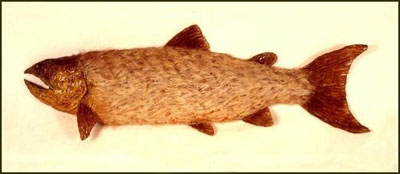 |
||||
 |
||||
The
Canadian "Hairy" Trout The Canadian Hairy Trout is a species of fish that possesses a thick coat of fur to keep itself warm in the cold waters where it lives. Canadian hairy trout can be found in most waters in Canada with the exception of Prince Edward Island and Manitoba. In Canada, three species of hairy trout are recognized. The average length of the fresh water form is 12-18 inches long and 18-24 inches in anadromous stocks. The colors of their furs are light gray, light green, light brown, dark greenish-brown, and almost black. The colors of their furs are said to be determined by the foods and chemical component of the water they live. These furry fish are primarily found in the northern regions of North America, but particularly in Montana, Colorado, Wyoming, and Canada. The species is also sometimes referred to as the Fur-bearing Trout, Furry Trout, Beaver Trout, or (incorrectly) as the Sabled Salmon. Captive breeding of this fish has not been successful. This creature spawns in late autumn to early winter in shallow, gravelly waters. The female digs a redd where she lays about 2000 eggs. This species is carnivorous and feeds on insects, crustaceans especially crayfish, molluscs, salamanders, frogs and rodents. Its hairs grow significantly longer during late autumn to early spring to keep its body warm and enables it to be active all year long. The Canadian hairy trout has enjoyed only limited success as a game fish in Canadian waters because it is difficult to catch. Several species of these furry fish are also found in the northern regions of North America such as Colorado, Wyoming, and Montana. Fur-Bearing trouts mounted as trophies can be found hanging on walls throughout the Great Lakes region of North America. Hairy trout mounted as trophies can be found hanging on walls throughout the Great Lakes region |
A number of theories have arisen in academic circles to explain this creature's luxuriant coat unlike any other species of trout or fish groups. Some say that the creature evolved its thick coat to protect itself from the extreme cold of northern waters. Today, some scientists say that this creature’s fur is actually a species of fresh water algae grows on the body due to the fish’s release of special chemicals during the cold seasons. As
the weather grows warmer during the spring the hairy trout sheds
its fur, only to regrow
its coat
as winter returns. This is why trout with
full coats of fur are so seldom encountered. During the summer months
when hairy trout usually do not have fur, the ones from streams have
pale markings on a dark greenish brown background. The back may be
covered with wormlike marks. Lake Superior fish are more silvery
with less distinct
markings. In both stream and lake fish, the tail is nearly square,
and the leading edge of each lower fin sometimes has a white margin. |
|||
 |
||||